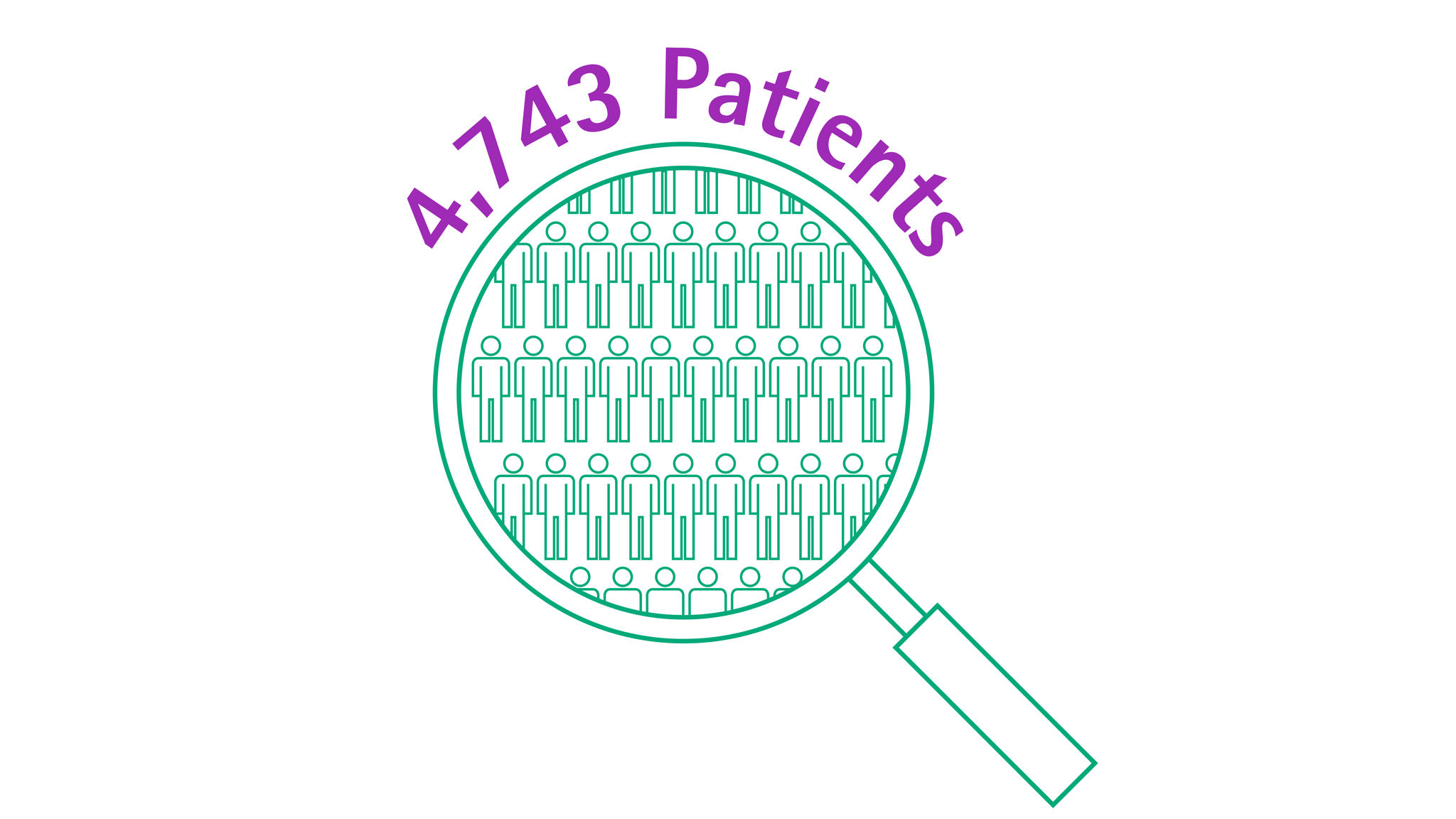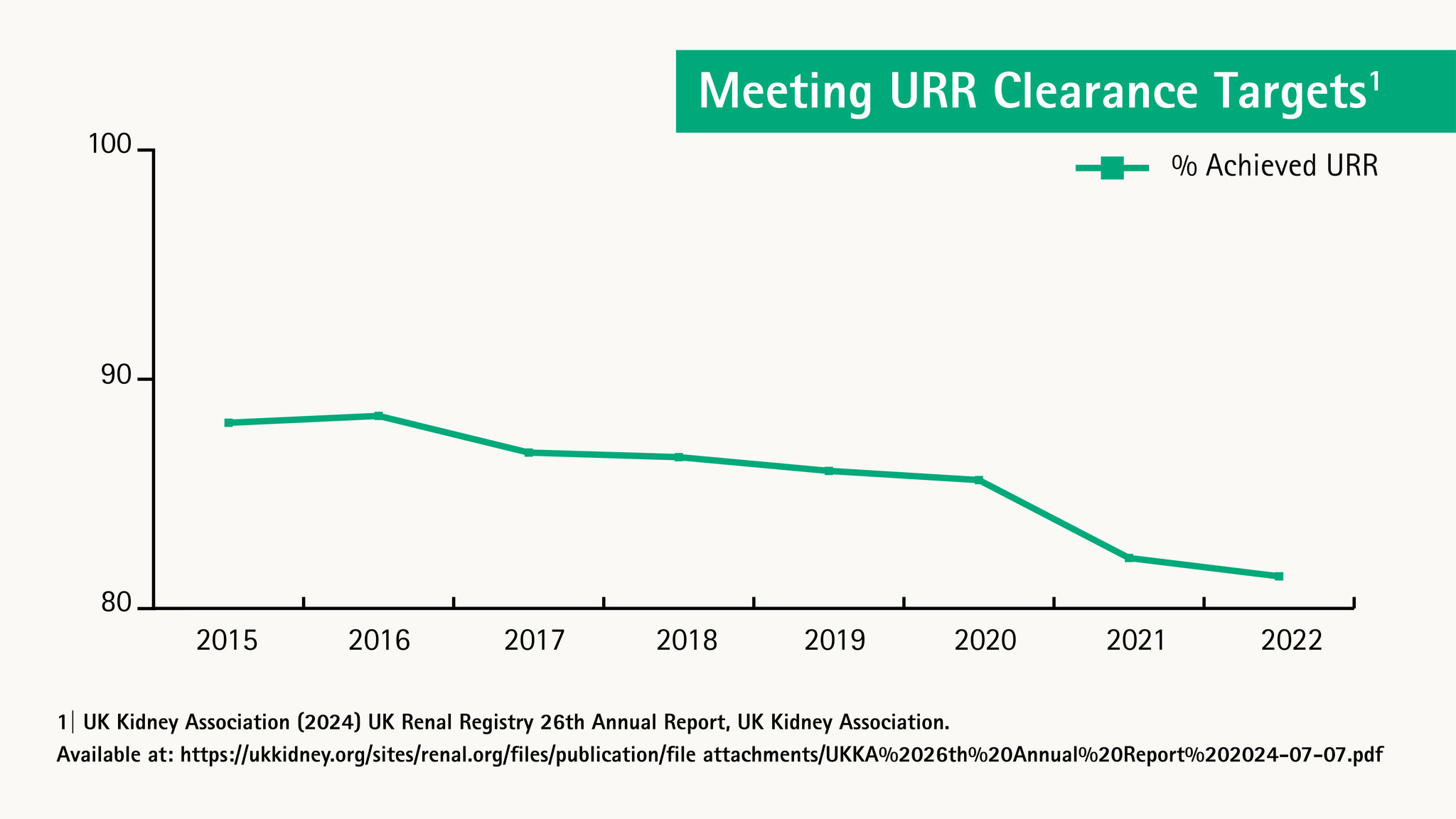No content results match your keyword.
Content
You have successfully logged out.
Not registered yet?
No content results match your keyword.
Content
No product results match your keyword.
Products
Real-time dialysis dose monitoring
Adimea ensures precise and real-time dialysis dose monitoring, enhancing patient outcomes1 and reducing complications2.

Real-time dialysis dose monitoring
Clearance refers to the rate at which waste products and excess fluids are removed from the patient's blood during a dialysis session. In the UK, guidelines recommend achieving a clearance of >65% URR or >1.2 Kt/V3. Currently,The National Kidney Foundation Kidney Disease Outcomes Quality Initiative (NKF-KDOQI) guidelines recommend that dialysis dose should be monitored at least monthly using blood samples. Published clearance data is available via the Renal Registry3
0%
Almost 1 in 5 patients in the UK do not achieve the URR >65% target.3
These 4,743 patients may be experiencing unnecessary symptoms and complications due to inadequate dialysis.

The Adimea system utilises sophisticated spectroscopy to measure urea concentration in spent dialysate, continuously throughout the treatment session. When the system detects that a patient might not achieve their clearance target, it triggers an alert, enabling immediate intervention. This real-time feedback loop transforms how we manage dialysis sessions, moving from reactive to proactive care.
Download Brochure

Given the decline in URR clearance rates since 2015, it is clear that there is a critical need for solutions that can ensure patients achieve the appropriate dialysis dose. With the Dialog iQ, rather than waiting for monthly blood tests to reveal problems, Adimea provides continuous feedback throughout each treatment session. This represents a paradigm shift in how we monitor and adjust dialysis treatment.
Adimea empowers caregivers to make informed intradialytic decisions.4 With every treatment adjustment, clearance is recalculated, allowing users to immediately see the impact of their changes. Research has demonstrated that real-time problem detection and intervention significantly enhances nursing care, promoting autonomy and boosting morale.1
Adimea-enabled clearance monitoring provides immediate problem identification, supports real-time interventions, offers instant feedback on effectiveness, and allows rapid optimisation of treatment parameters. This transformation significantly reduces the time between identifying and resolving issues, allowing for corrections within a single treatment session or a few days. This is a stark contrast to the traditional process, which relies on monthly blood tests, delayed problem identification, and extended cycles of trial and error.1, 5
Adimea can indirectly indicate potential vascular access issues, such as recirculation or clotting1. Dialog iQ's continuous monitoring of blood flow, UF rate, dialysate pressure, and temperature, alongside clearance trends can reveal patterns indicative of vascular access problems. Therefore, reducing complications and improving access longevity.2
Approximately half of haemodialysis patients struggle with treatment adherence6, highlighting the importance of patient engagement. Dialog iQ's Adimea feature enhances adherence1 by providing clear treatment targets and involving patients in their treatment7. The visual feedback connects patients' actions to their outcomes, making the concept of dialysis more tangible. By showing how full dialysis sessions affect clearance levels, the system acts like a supportive coach, offering immediate, encouraging feedback to maintain motivation.
0%
Haemodialysis patients are hospitalised nearly twice a year8, with 37% facing readmission within a month.9
0%
Hospitalisations due to vascular-access related complications, accounting for nearly one-third of hospital admissions.10
£ 0M
Amount for fistula procedures in 2021/22. Saving a fistula is more cost effective than creating a new one!12
Adimea Brochure
pdf, 2.2 MB
Adimea Patient Leaflet
pdf, 1.7 MB
Automated Monitoring of Adequacy
Kidney International, (2010) 833-835. doi:10.1038/ki.2010.218
pdf, 226.5 KB
Dialysis Dose and Clearance Variation
pdf, 272.6 KB
Ensuring Hemodialys Adequacy by Dialysis
pdf, 884.3 KB
Adimea Quick Reference Guide
pdf, 1.4 MB
Please complete the form below to contact our Renal team.
1. Ross, E.A., Paugh-Miller, J.L. and Nappo, R.W. (2018) 'Interventions to improve hemodialysis adequacy: protocols based on real-time monitoring of dialysate solute clearance', Clinical Kidney Journal, 11(3), pp. 394–399.
2. Advanced Renal Education (2021) 'Vascular Access Monitoring and Surveillance – Advanced Renal Education Program'. Available at: https://advancedrenaleducation.com/wparep/article/vascular-access-monitoring-and-surveillance/ (Accessed: 18 February 2025).
3. UK Kidney Association (2024) UK Renal Registry 26th Annual Report. Available at: https://ukkidney.org/sites/renal.org/files/publication/file-attachments/UKKA%2026th%20Annual%20Report%202024-07-07.pdf (Accessed: 7 July 2024).
4. Uhlin, F., et al. (2006) 'Dialysis dose (Kt/V) and clearance variation sensitivity using measurement of ultraviolet-absorbance (on-line), blood urea, dialysate urea and ionic dialysance', Nephrology Dialysis Transplantation, 21(8), pp. 2225-2231. doi: 10.1093/ndt/gfl147.
5. Daugirdas, J.T. and Tattersall, J.E. (2010) 'Automated monitoring of hemodialysis adequacy by dialysis machines: potential benefits to patients and cost savings', Kidney International, 78(9), pp. 833-835. doi: 10.1038/ki.2010.218.
6. Ibrahim, S., Hossam, M. and Belal, D. (2015) 'Study of non-compliance among chronic hemodialysis patients and its impact on patients′ outcomes', Saudi Journal of Kidney Diseases and Transplantation, 26(2), pp. 243-249.
7. Zhang, L., Liu, W., Hao, C., et al. (2022) 'Ensuring hemodialysis adequacy by dialysis dose monitoring with UV spectroscopy analysis of spent dialyzate', The International Journal of Artificial Organs, 45(4), pp. 351–359.
8. Streja, E. (2017) 'Hospital readmission for the dialysis patient: who is (not) responsible?', Kidney International, 92(4), pp. 788–790. Available at: https://www.kidney-international.org/article/S0085-2538(17)30396-4/fulltext (Accessed: 16 April 2021).
9. Xu, Y., Li, L., Evans, M., Xu, H., Lindholm, B. and Carrero, J.J. (2021) 'Burden and causes of hospital admissions and readmissions in patients undergoing hemodialysis and peritoneal dialysis: a nationwide study', Journal of Nephrology, 34(4), pp. 1949–1959. doi: 10.1007/s40620-021-01023-z.
10. Mathew, A.T., Strippoli, G.F.M., Ruospo, M. and Fishbane, S. (2015) 'Reducing hospital readmissions in patients with end-stage kidney disease', Kidney InternationaL, 88(6), pp. 1250–1260. Available at: https://www.kidney-international.org/article/S0085-2538(15)61071-7/pdf (Accessed: December 2024).
11. Chan, K.E., Lazarus, J.M., Wingard, R.L. and Hakim, R.M. (2009) 'Association between repeat hospitalization and early intervention in dialysis patients following hospital discharge', Kidney International, 76(3), pp. 331–341.
12. Brooke, B.S., Griffin, C.L., Kraiss, L.W., Kim, J. and Nelson, R. (2019) 'Cost-effectiveness of repeated interventions on failing arteriovenous fistulas', Journal of Vascular Surgery, 70(5), pp. 1620-1628.
13. Murali, K.M. & Lonergan, M. (2020). 'Breaking the adherence barriers: Strategies to improve treatment adherence in dialysis patients', Seminars in Dialysis, 33(6), pp. 475-485. Available at: https://doi.org/10.1111/sdi.12925.
14. Hu, L., Wang, Z. & He, X. (2024). 'Hemodialysis dose and frequency should be considered in subgroup analysis', *Cardiovascular Diabetology*, 23, 416. Available at: https://doi.org/10.1186/s12933-024-02482-x.
15. Castellarnau, A., Werner, M., Günthner, R. and Jakob, M., (2010). Real-time Kt/V determination by ultraviolet absorbance in spent dialysate: technique validation. Kidney International, 78(9), pp.920-925.